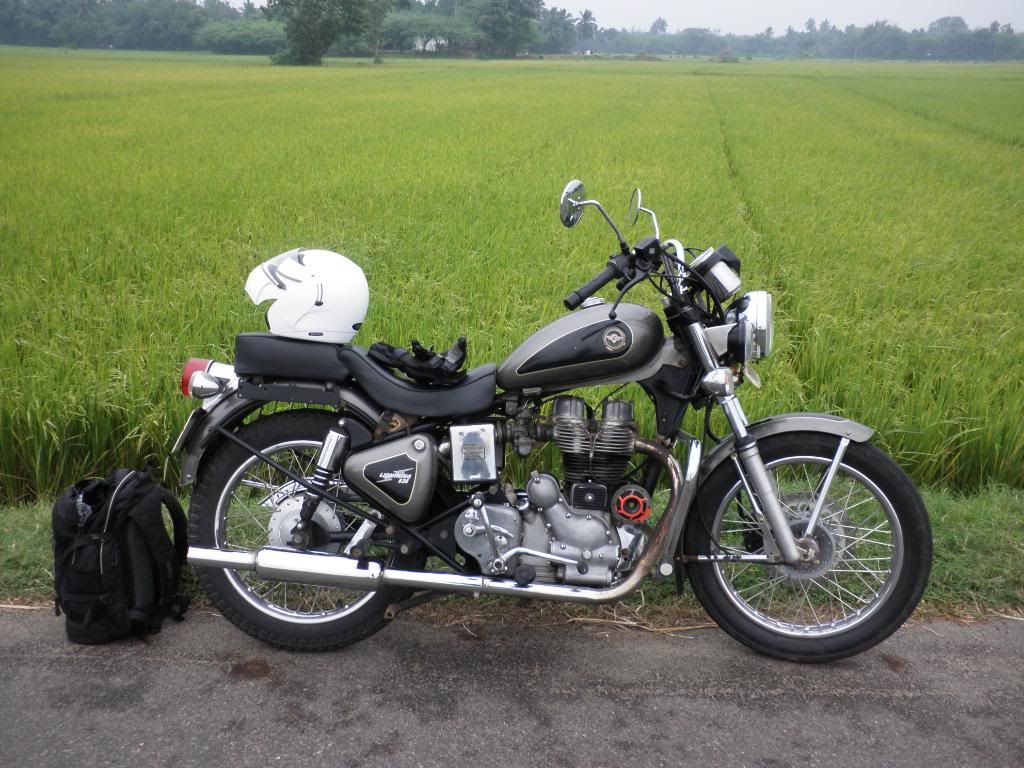There's a lot of riding folklore out there, passed on from the mists of time... Not all of it is accurate or logical.
One of the most common myths is about the use of the front brake - Indeed as a kid, when I first rode a bicycle, I was told by my friends "Never use the front brake! The bicycle will somersault!"
I was too dumb then to realize that physics does not bear this out. Indeed I never ever did use the front brakes on my bicycle ever, for the brief time that I did ride one!
When I graduated to a motorbike, however, I had read enough at msgroup.org and various other locations on the internet to realize that the front brake is where it's at.
My first motorbike was an Enfield Bullet Lightning 535 as seen here (this is not my bike)
It's essentially a beefed up 500 bullet with :
- 535 cc's - Bore 87mm vs the 84 mm of a 500, producing a claimed 26 crank HP, and bigger oil rocker feed lines.
- Fritz Egli design "high speed" forged piston - a real lemon - this piston is prone to seize or become very loose and clattery - also they cost a fortune. Thankfully I never had one seize, although the first one cracked - I've since "downgraded" to a solid UK made cast piston, cheap and robust..
- Disc brakes
- "Cruiser" styling
When I first rode the bike, I fell several times, almost always by locking the front wheel on sandy patches. For some reason the cruiser style handlebars and the seating made for a vague front end, similar to the Bullet Thunderbird, and totally unlike the way an old Standard 350 Bullet handles.
The default Dunlop ribbed front tyre didn't help the cause much - for a while I doubted my ability to ride, and was chided by several (non-biking) peers about my "incorrect" braking technique.
After a big T-bone accident I had at about 50MPH (which bent the frame down tube by sheer impact force), we rebuilt the bike onto a standard 350 frame, while retaining the original handle tee.
Since then the bike handles perfectly, and last year, after the addition of a Pirelli MT60 front tyre, I have never been able to get the front wheel to skid, even under relentless braking. Meanwhile the rear wheel can break traction even under over-aggressive down shifting.
So the whole "use front brakes unless you are in a curve" theory is vindicated.
What I've never been able to figure out completely is why the Thunderbird style seating and handlebars give rise to front end instability.
Here's an interesting observation though - If you trace the paths of ends of the handlebar from lock to lock, you will find a big difference between that of the Thunderbird and the Standard Bullet and how my bike is set up :
Figures are not very accurate and a bit exaggerated since the handlebar is a complex shape, but the idea is pretty clear.
Something radically good in terms of control seems to happen when the handlebar ends are between 9 o' clock and 3 o' clock positions. Gets progressively bad as they come towards 6 o'clock, as evidenced by the better handling of the Standard as compared to the Thunderbird and even better handling on my bike which has the Standard handlebar mounted in the Thunderbird tee yoke.
Perhaps is as simple as the fact that the further ahead the bars are, the more forward the rider weight goes, or maybe its the arc that the arms trace - consider driving a car with the hands on top of the wheel vs. hands at the bottom.
It could be the fact that close to 9 and 3 o clock, lateral movement of the hands is almost nil, only forward backward motion is involved.
Whatever it is, it's quite surprising that mild change in seating position and handlebars alone can affect the feel of a bike so much!




No comments:
Post a Comment